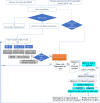A regional population-based hereditary breast cancer screening tool in Italy: First 5-year results
- PMID: 32045136
- PMCID: PMC7131858
- DOI: 10.1002/cam4.2824
A regional population-based hereditary breast cancer screening tool in Italy: First 5-year results
Abstract
Background: Up to 10% of individuals with breast cancer (BC) belong to families with hereditary syndromes. The aim of this study was to develop an instrument to identify individuals/families at high-hereditary risk for BC and offer dedicated surveillance programs according to different risks.
Methods: The instrument consisted of a primary questionnaire collecting history of BC and ovarian cancer (OC). This questionnaire was applied to women enrolled in the Emilia-Romagna Breast Cancer Screening Program. General practitioners (GPs) and specialists could propose the same questionnaire too. Women with a score of ≥ 2, were invited to complete an oncogenetic counseling. According to the Tyrer-Cuzick evaluation, women considered at high risk were invited to involve the most representative alive individual of the family affected with BC/OC for BRCA1/2 genetic testing.
Results: Since January 2012 and December 2016, 660 040 women were evaluated by the regional screening program, of which 22 289 (3.5%) were invited to the Spoke evaluation, but only 5615 accepted (25.2%). Totally, also considering women sent by GPs and specialists, 11 667 were assessed and 5554 were sent to the Hub evaluation. Finally, 2342 (42.8%) women fulfilled the criteria for genetic testing, and 544 (23.2%) resulted BRCA1/2 mutation carriers.
Conclusions: To our knowledge, this is the first regional population-based multistep model that is aimed to identify individuals with BRCA1/2 mutations and to offer an intensive surveillance program for hereditary-high risk women. This tool is feasible and effective, even if more efforts must be performed to increase the acceptance of multiple assessments by the study population.
Keywords: Tyrer-Cuzick model; hereditary breast ovarian cancer; population-based screening.
© 2020 The Authors. Cancer Medicine published by John Wiley & Sons Ltd.
Conflict of interest statement
The authors declare that they have no financial disclosure and conflict of interests.
Figures
References
-
- Samadder NJ, Giridhar KV, Baffy N, Riegert‐Johnson D, Couch FJ. Hereditary cancer syndromes‐a primer on diagnosis and management: part 1: breast‐ovarian cancer syndromes. Mayo Clin Proc. 2019;94(6):1084‐1098. - PubMed
-
- Gómez‐Flores‐Ramos L, Álvarez‐Gómez RM, Villarreal‐Garza C, Wegman‐Ostrosky T, Mohar A. Breast cancer genetics in young women: What do we know? Mutat Res. 2017;774:33‐45. - PubMed
-
- Cybulski C, Nazarali S, Narod SA. Multiple primary cancers as a guide to heritability. Int J Cancer. 2014;135(8):1756‐1763. - PubMed
-
- Eng C. Mendelian genetics of rare–and not so rare–cancers. Ann N Y Acad Sci. 2010;1214:70‐82. - PubMed
Publication types
MeSH terms
Substances
Supplementary concepts
LinkOut - more resources
Full Text Sources
Medical
Miscellaneous



